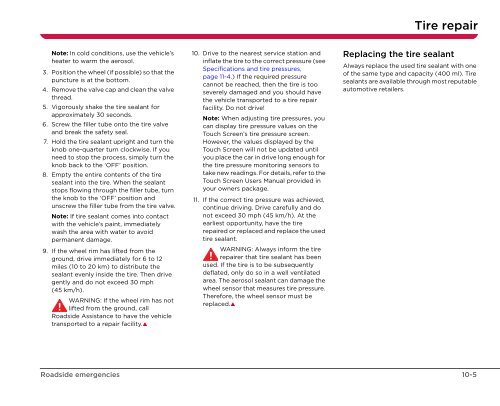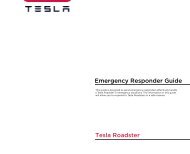Create successful ePaper yourself
Turn your PDF publications into a flip-book with our unique Google optimized e-Paper software.
Tire repair<br />
Note: In cold conditions, use the vehicle’s<br />
heater to warm the aerosol.<br />
3. Position the wheel (if possible) so that the<br />
puncture is at the bottom.<br />
4. Remove the valve cap and clean the valve<br />
thread.<br />
5. Vigorously shake the tire sealant for<br />
approximately 30 seconds.<br />
6. Screw the filler tube onto the tire valve<br />
and break the safety seal.<br />
7. Hold the tire sealant upright and turn the<br />
knob one-quarter turn clockwise. If you<br />
need to stop the process, simply turn the<br />
knob back to the ‘OFF’ position.<br />
8. Empty the entire contents of the tire<br />
sealant into the tire. When the sealant<br />
stops flowing through the filler tube, turn<br />
the knob to the ‘OFF’ position and<br />
unscrew the filler tube from the tire valve.<br />
Note: If tire sealant comes into contact<br />
with the vehicle’s paint, immediately<br />
wash the area with water to avoid<br />
permanent damage.<br />
9. If the wheel rim has lifted from the<br />
ground, drive immediately for 6 to 12<br />
miles (10 to 20 km) to distribute the<br />
sealant evenly inside the tire. Then drive<br />
gently and do not exceed 30 mph<br />
(45 km/h).<br />
WARNING: If the wheel rim has not<br />
lifted from the ground, call<br />
Roadside Assistance to have the vehicle<br />
transported to a repair facility.<br />
10. Drive to the nearest service station and<br />
inflate the tire to the correct pressure (see<br />
Specifications and tire pressures,<br />
page 11-4.) If the required pressure<br />
cannot be reached, then the tire is too<br />
severely damaged and you should have<br />
the vehicle transported to a tire repair<br />
facility. Do not drive!<br />
Note: When adjusting tire pressures, you<br />
can display tire pressure values on the<br />
Touch Screen’s tire pressure screen.<br />
However, the values displayed by the<br />
Touch Screen will not be updated until<br />
you place the car in drive long enough for<br />
the tire pressure monitoring sensors to<br />
take new readings. For details, refer to the<br />
Touch Screen Users <strong>Manual</strong> provided in<br />
your owners package.<br />
11. If the correct tire pressure was achieved,<br />
continue driving. Drive carefully and do<br />
not exceed 30 mph (45 km/h). At the<br />
earliest opportunity, have the tire<br />
repaired or replaced and replace the used<br />
tire sealant.<br />
WARNING: Always inform the tire<br />
repairer that tire sealant has been<br />
used. If the tire is to be subsequently<br />
deflated, only do so in a well ventilated<br />
area. The aerosol sealant can damage the<br />
wheel sensor that measures tire pressure.<br />
Therefore, the wheel sensor must be<br />
replaced.<br />
Replacing the tire sealant<br />
Always replace the used tire sealant with one<br />
of the same type and capacity (400 ml). Tire<br />
sealants are available through most reputable<br />
automotive retailers.<br />
Roadside emergencies<br />
10-5







